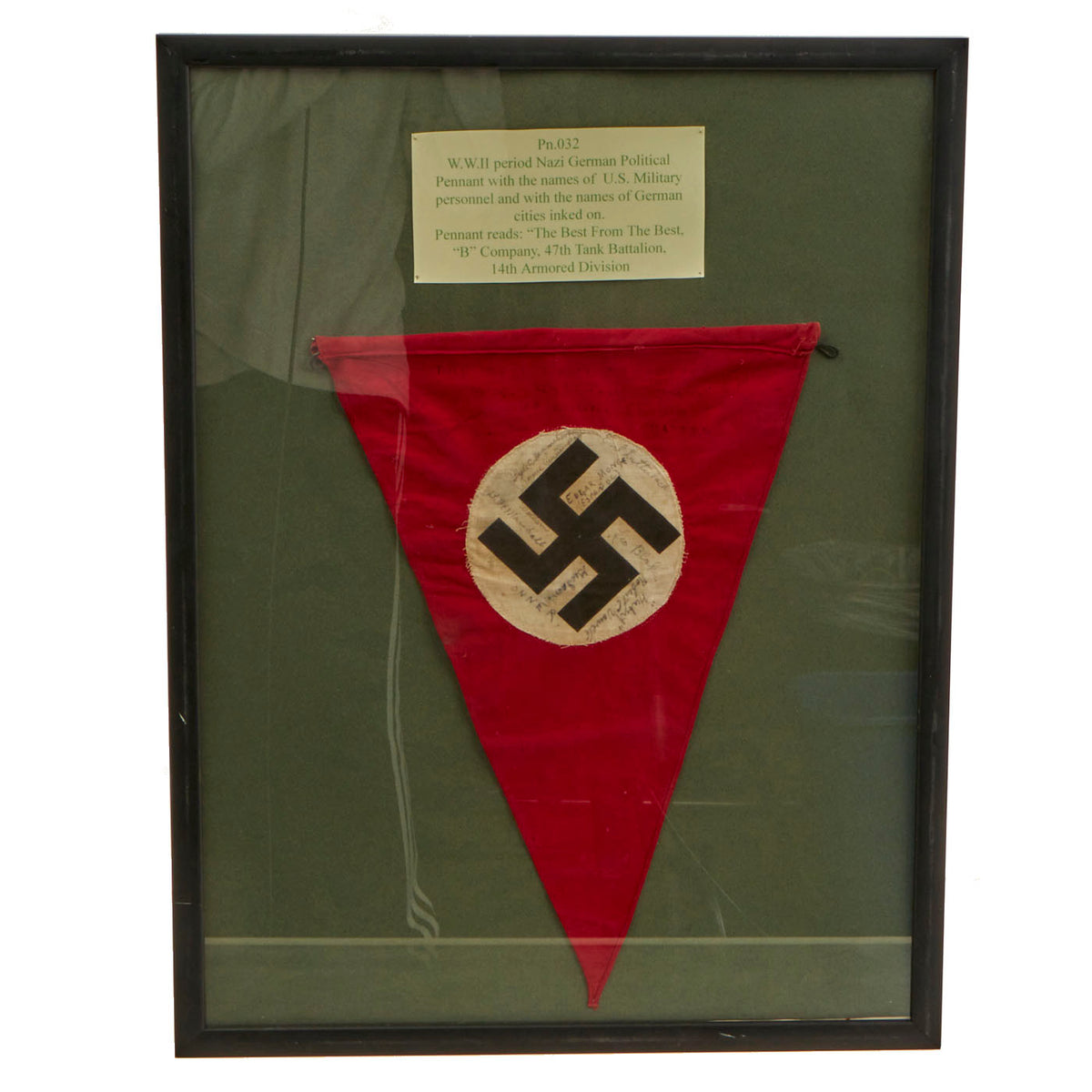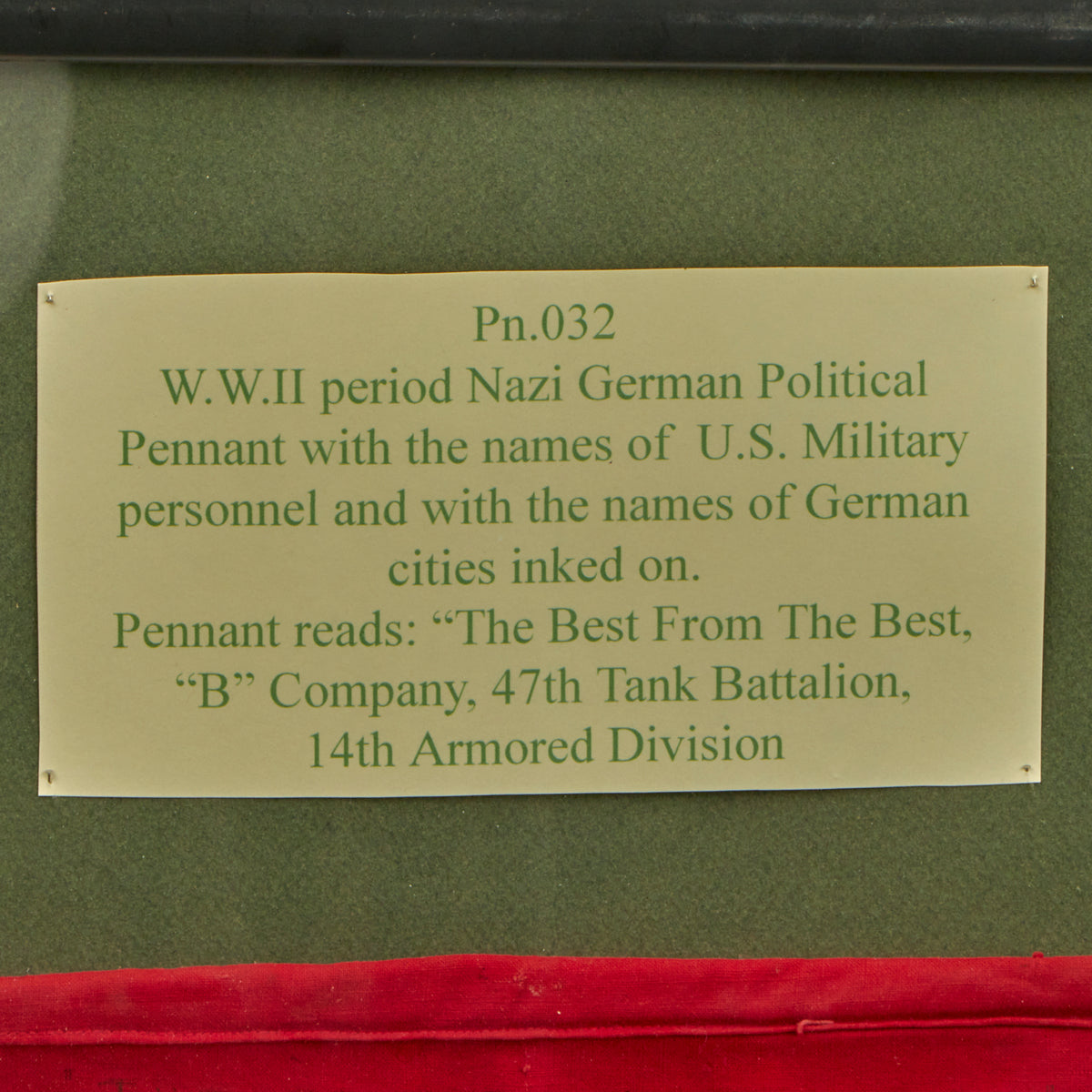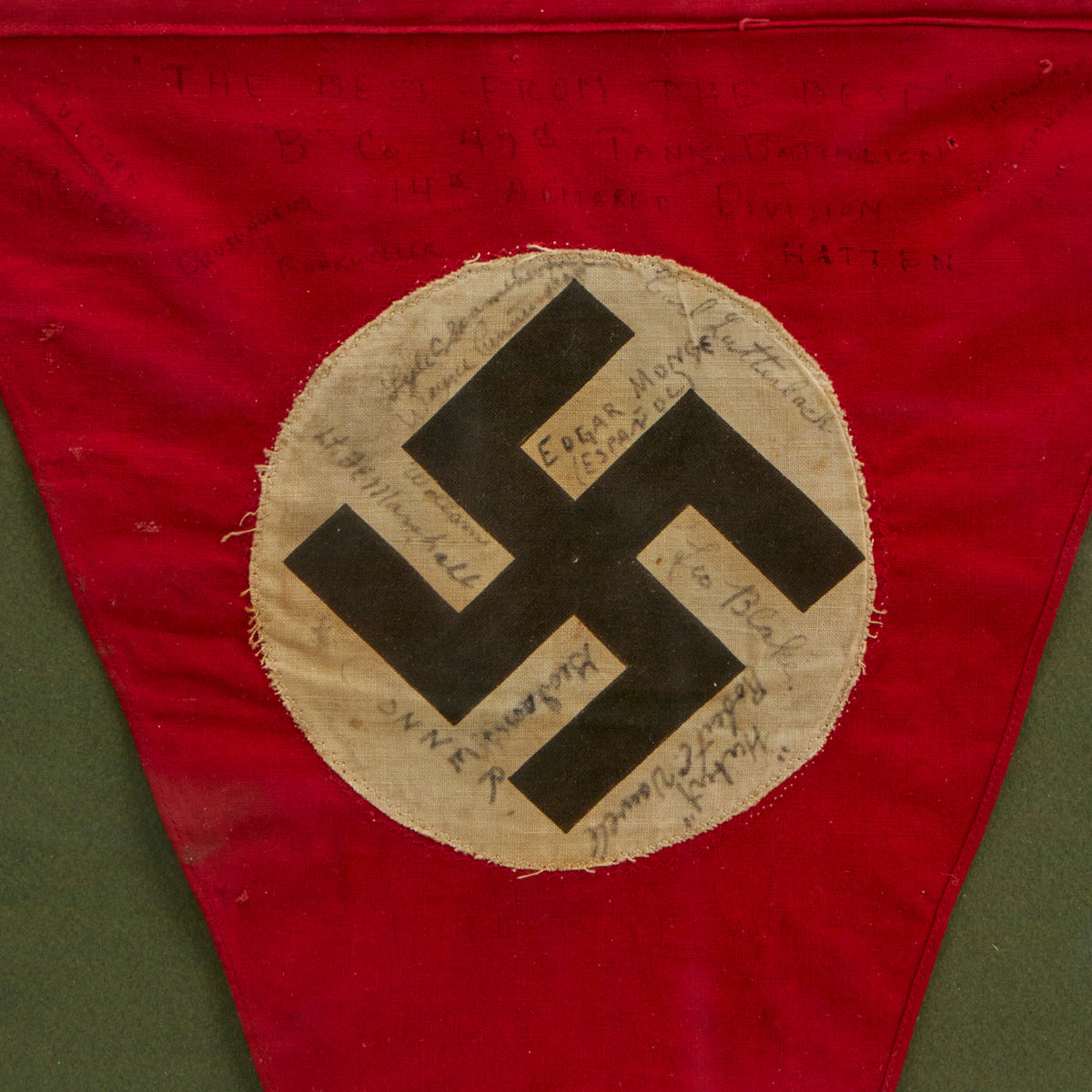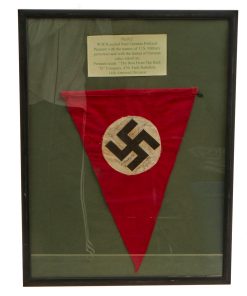Original German WWII Framed USGI Bring Back NSDAP Pennant – 47th Tank Battalion, 14th Armored Div. Original Items
$ 895,00 $ 223,75
Original Item: Only One Available. This is a wonderful USGI Bring back example of a WWII German NSDAP National Flag Car / Automobile / Vehicle Wimpel (Pennant). These would be flown on a small staff attached to the fender of the automobile or other vehicle it was attached to. The pennant is of multi-piece construction, and has standard red field with a stitched on white circle bearing the NSDAP Swas (Hook Cross). It measures approximately 17″ in fly and 12″ in height, with a metal rod through the header.
There is a label at the top, indicating the text written across the pennant by the header, which
“THE BEST FROM THE BEST”
“B” Co. 47th TANK BATTALION
14TH ARMORED DIVISION
Around this on the red field of the pennant look to be the names of Cities and other locations the unit was in during the war. They are faint, so we are not able to make out many. The white circle around the Swas is marked with the names and nicknames of soldiers in the Battalion. The pennant itself is mounted inside a glass glazed frame that measures 25 1/4″ x 19 1/4″ x 1 1/2″.
A fantastic genuine battlefield trophy signed by a group of U.S. tanker troops during the fall of the Third Reich in World War Two. A great display piece with lots of research potential!
More on the 14th Armored Division:
The 14th Armored Division was an armored division of the United States Army assigned to the Seventh Army of the Sixth Army Group during World War II. It remains on the permanent roll of the Regular Army as an inactive division, and is eligible for reactivation. The division is officially nicknamed the “Liberators”.
The 14th Armored Division was constituted and added to the roll of the US Army on 28 August 1942; it was activated on 15 November in a ceremony at Camp Chaffee, Arkansas. It was organized initially as a heavy division with two armored regiments (the 47th and 48th) and one armored infantry regiment, the 62nd Infantry Regiment. It was reorganized from a heavy division to a light division on 20 September 1943. The reorganization saw the loss of two tank battalions from the Armored regiments, one battalion each. The 1st Battalion of the 47th Armor was redesignated as the 786th Tank Battalion and the 3rd Battalion of the 48th Armor was redesignated as the 716th Tank Battalion.
The division departed Camp Chaffee in November to participate in the 2nd Army maneuvers in Tennessee from 17 November 1943 until 10 January 1944. At the conclusion of the exercise, the division was assigned to Camp Campbell, Kentucky. The division remained at Camp Campbell until late September when it was alerted for movement to the ETO (European Theater of Operations) via Camp Shanks, New York where it went for final processing. Units departed Camp Campbell on 1 October and completed their arrival at Camp Shanks on the 6th of that month. After completing their processing, the division boarded four transport ships for deployment on 13 October 1944.
The 14th Armored Division landed at Marseille in southern France, on 29 October 1944. Within two weeks some of its elements were in combat, maintaining defensive positions along the Franco-Italian frontier. The division was assigned to US 6th Army Group on 1 November. On 10 November, the division was assigned to US Seventh Army. On 12 November the Combat Command Reserve (CCR) was detached, and ordered to the Maritime Alps by 6th Army Group to relieve units in defensive positions there. On 15 November, Combat Command A moved north from the area of Marseille to Epinal to take part in the VI Corps drive through the Vosges Mountains, and was followed by Combat Command B five days later. Hard fighting at Gertwiller, Benfeld, and Barr helped VI Corps to crack the German defenses, the division was on the Alsatian Plain in early December. On 17 December the division attacked across the Lauter River into Germany itself, along with the other units of VI Corps, it fought its way into a heavily defended portion of the German Westwall. Due to the growing crisis in the Ardennes, General Eisenhower, the supreme commander, ordered the Seventh Army to stop its attack and withdraw from the Westwall, where its units assumed positions south of the Lauter River. The order was poorly timed as elements of the 14th Armored Division had penetrated deep into the German defenses, and were poised to break out into the enemy’s rear.
The division then took part in operations across Europe, eventually helping to liberate POW, Forced labor, and concentration camps as the German forces collapsed. Following the war, the division was deactivated upon return to the United States.
Fast Shipping with Professional Packaging
Thanks to our longstanding association with UPS FedEx DHL, and other major international carriers, we are able to provide a range of shipping options. Our warehouse staff is expertly trained and will wrap your products according to our exact and precise specifications. Prior to shipping, your goods will be thoroughly examined and securely secured. We ship to thousands clients each day across multiple countries. This shows how we're dedicated to be the largest retailer on the internet. Warehouses and distribution centres can be located throughout Europe as well as the USA.
Note: Orders with more than one item will be assigned a processing date depending on the item.
Before shipping before shipping, we'll conduct a thorough inspection of the items you have ordered. Today, the majority of orders will be delivered within 48 hours. The delivery time will be between 3-7 days.
Returns
The stock is dynamic and we cannot completely manage it because multiple stakeholders are involved, including our factory and warehouse. So the actual stock may alter at any time. It's possible that you may not receive your order once the order has been made.
Our policy is valid for a period of 30 days. If you don't receive the product within 30 days, we are not able to issue a refund or an exchange.
You can only return an item if it is unused and in the same state as the day you received it. You must have the item in its original packaging.
Related products
Uncategorized
Uncategorized
Armoured Fighting Vehicles of the World: AFVs of World War One (Hardcover Book) New Made Items
Uncategorized
Uncategorized
Uncategorized
Uncategorized
Uncategorized
Uncategorized
Band of Brothers ORIGINAL GERMAN WWII Le. F.H. 18 10.5cm ARTILLERY PIECE Original Items
Uncategorized
Uncategorized
Uncategorized
Uncategorized
Uncategorized
Uncategorized
Uncategorized
Uncategorized
Uncategorized
Uncategorized
Australian WWII Owen MK1 Machine Carbine SMG Custom Fabricated Replica with Sling Original Items








































































